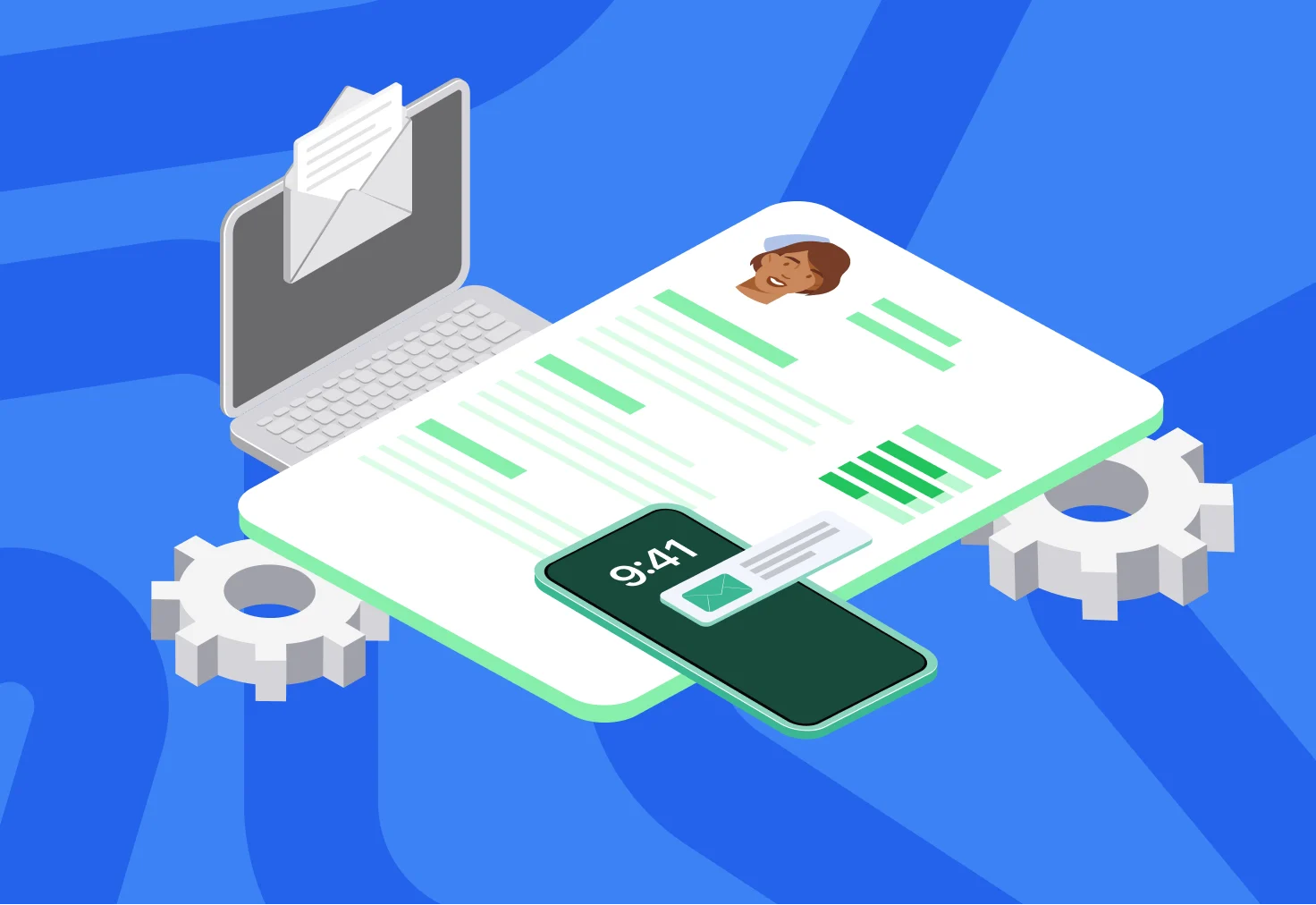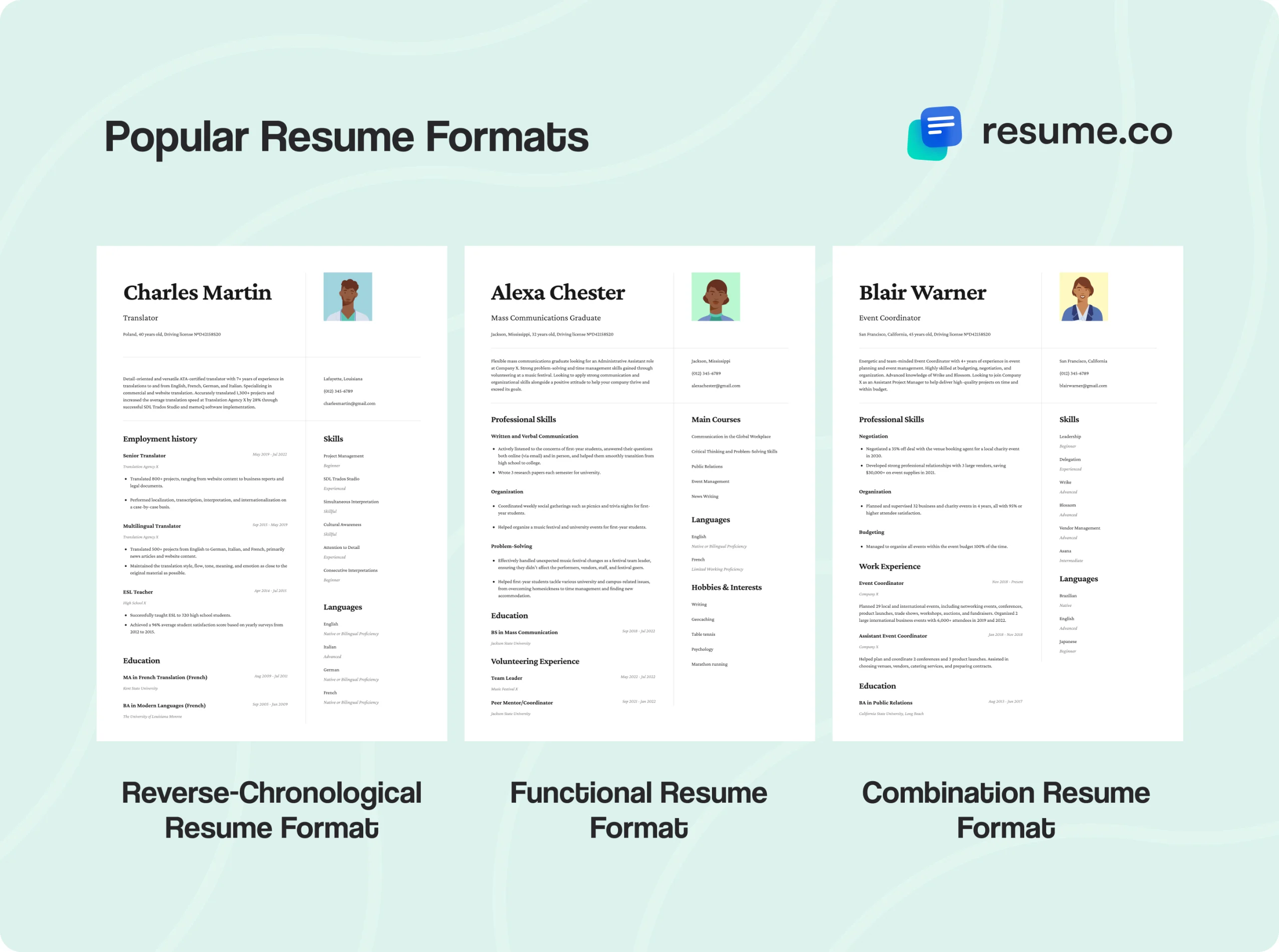Recruiters don’t read the majority of resumes. Instead, they skim through these or scan them, only focusing on the ones that make a good first impression. For this reason, choosing a suitable resume layout is essential for emphasizing your most relevant information and presenting it clearly.
A good resume layout will immediately catch the eye of the hiring manager, while a bad one won't even make it through the scanning process.
Having this in mind, it’s crucial to familiarize yourself with proper resume layout practices. That’s how you’ll be able to create a job-winning resume that will be easy to scan, read, and remember.
Keep reading to learn how to do it with zero fuss!
Key Takeaways
A resume layout represents the way you organize sections and information in your resume.
The best resume layout template features a created hierarchy where you list the information from the most to the least important.
The information in your resume should be concise and to the point. Only list the education details, skills, and achievements relevant to the position you’re applying for.
When designing your resume layout, you need to choose a suitable font, determine the length of your resume, and pick the right text alignment option.
The three most common resume layouts are chronological, functional, and combination (hybrid).
To easily create a solid resume layout, you should use Google Docs or MS Word resume layouts as a starting point.
What is a Resume Layout?

A resume layout represents the way you organize sections and insert information in your resume. It encompasses everything—from a header with your contact information to the optional bonus sections that showcase additional education, skills, or achievements.
A good resume layout makes different sections visually distinct. This way, if a recruiter scans your resume for even a few seconds, they’ll find exactly what they’re looking for. By organizing relevant information, you allow recruiters to effortlessly go from your resume summary to your hard skills, soft skills, work history, and so on.
Also, even though some people use terms “layout” and “template” interchangeably, these two words don’t have the same meaning.
While a layout represents an arrangement of resume sections, a template, on the other hand, is a layout preset. It’s an established layout you can copy, paste, and fill with your own information.
Best Resume Layout Template to Get Hired in 2025
If you’re wondering where to begin when creating a resume layout, take a look at the following template. You can copy and paste it, fill it with your own information, and see an instant improvement in your resume.
Template #1
[Full name] [Job title] [City and state] [Phone number] [Email address] [Additional contact information: the link to your LinkedIn profile, social media profiles, etc.] [Resume summary]
Work Experience
[Position] [Company] [Start and end date of employment] [A bullet point list containing the crucial responsibilities and achievements within the role]
Education
[Degree/Name of the program] [Institution] [Date of attendance—start and end date] [Additional information]
Skills
[A bullet point list containing your most prominent soft and hard skills]
Certificates and courses
[A bullet point list of relevant courses and certifications you’ve achieved]
Languages
[A bullet point list of languages you speak along with proficiency levels]
Volunteer Experience
[Your role in the volunteering program] [Company/Organization] [Location] [Start and end date of volunteering] [A short bullet point list containing the crucial achievements and contributions within the role]
Awards and honors
[A bullet point list containing all relevant awards and honors]
Pro tip
As you’re approaching the end of the list, some of the sections become optional. The language part, for example, is not relevant in some lines of work, though it could be a priority in others.
What Information to Put on a Resume?
If you revised the free resume layout we listed in the previous section, you already have a good idea of what information to put on your resume. Still, it doesn’t hurt to explain what each of these sections should contain:
Resume Sections
Contact information is self-explanatory. It allows recruiters to get in touch with you once they’ve seen your resume.
Resume summary is the catchiest part of your resume and the best way to briefly introduce yourself to the recruiter. Its goal is to convince the hiring manager to keep reading.
Work experience section is usually the most important part of your resume. It directly shows what kind of work you’ve been doing and gives recruiters a general idea of whether you’re a good fit for their company.
Education often comes next, showing your knowledge and qualifications. Plus, you can leverage your academic history if you’re new to the industry and lack relevant work experience.
Soft and hard skills usually follow the education section. You should start it by listing the most relevant hard skills you have. Continue by adding some prominent soft skills, but make sure you don’t mix them with hard ones.
Additional resume sections should come last. You can talk about your career objectives, volunteer experience, hobbies and interests, and so on. Being creative while remaining professional in this section allows you to finish your resume on a high note and ensure the recruiters remember you.
How to Design Your Resume Layout
Designing your resume layout in a proper way helps you get hiring managers to pay attention to your application, which makes it an essential part of the resume preparation.
Font
The majority of your resume is text. Because of that, choosing the right font for your resume can be a deciding factor between getting the recruiter to read it and making them move on to the next candidate.
Start by choosing whether you want to use a serif or a sans-serif font. Depending on your industry, one group will work much better than the other.
Serif fonts (those with tails) are classy and elegant, and they are suited for more traditional jobs. Sans serif fonts (those without tails) are clean and modern. They are a great choice for tech positions and startups.
Spacing
Spacing is essential as it directly impacts readability. Therefore, it’s important to find a balance between making your resume legible and not having too much space between the lines.
Up to 1.5-point spacing is generally adequate. If you opt for a small font size, you should reduce the spacing so that it looks natural.
Also, you should always aim to use a legible font. However, if you decide on the less readable one in the group, see if you need to increase spacing slightly.
Finally, make sure to leave more space between different sections, as well as before and after headers.
Margins
Similar to spacing, margins are all about making your resume look organized, professional, and readable. If your resume margins are too big, they’ll make your document look empty. If they are too small, the resume might look messy.
The top and bottom margins should be up to 0.5 inches in most cases. As for the side margins, they should be at least 0.75 inches. Following these two rules will ensure you end up with a professional resume layout.
Adjust margins in combination with spacing to get the desired effect. The goal is to end up with a simple resume layout that is easy to scan and read but without too much whitespace.
Alignment
Most professional documents have left or justified alignment. It’s the standard alignment that most people are used to, which makes the text easy to read.
Having this in mind, you should keep the same alignment on your resume. Headings can be an exception to this rule, as central or right alignment might work better for them. Still, left-aligned headings are the safest choice.
Bullet Points
Bullet points are an incredible tool for emphasizing information. They are easy to read and can turn an ordinary block of text into a captivating segment.
To make bullet points highly effective, focus on quality and concrete information. Instead of making general descriptions, be precise when talking about your skills and achievements. Also, don’t be afraid to use numbers to quantify the results and make them more noticeable.
The best way to create a strong list of bullet points is to start each of them with action verbs and power words. A combination of influential words and the eye-catching ability of bullet points will make your work history, skills, and achievements stand out.
Length
Generally, resumes should be one page long. This is not a required length, but it’s the best measure for a professional layout that many hiring managers prefer and recommend.
The goal is to aim for quality over quantity. Unless you have decades of professional experience, you can probably fit all the information on one page. Due to this, a one-page resume is perfect for both beginners and mid-level professionals.
However, there are some cases when longer resumes are acceptable or even necessary. For example, a job posting might require a lengthy resume. Similarly, longer resumes might be common in specific lines of business.
Also, if you’re a senior-level executive who would benefit from demonstrating an outstanding record of performance, you could go for 2 or even 3 pages.
3 Most Common Resume Format Layouts
Resume formats represent specific resume layouts perfected by professionals. The three most popular resume formats to best showcase your credentials and make your document stand out are:
Common Resume Formats
Chronological resume
Functional resume
Combination (hybrid) resume

Chronological Resume Layout
A chronological resume layout is an excellent all-around format that lists your work history starting from the most recent experiences and academic achievements. It is straightforward, well-structured, and easy to create and read. As a result, it’s one of the most commonly used ones.
Functional Resume Layout
The functional resume layout is more creative than the chronological one. It highlights your skills over your work experience, which is why it’s great for entry-level positions and creative jobs.
The downside of the functional resume format is that it’s harder to scan than a chronological format. It might run into issues with ATS, which may reject it even before it reaches the hiring managers.
Combination (Hybrid) Resume Layout
As the name suggests, a combination resume layout is a mix of the functional and chronological resume formats. It’s best used by professionals who have plenty of experience to pair with their extensive skills.
The goal of this resume format is to highlight your skills while also connecting them with relevant accomplishments. That way, you showcase the best of both worlds at the same time in a highly effective way.
Here is a good Google Docs resume layout to get you started. This one is perfect if you’re new to the market and are creating your first resume. With bigger margins and spacing, you can create a professional resume even if you don’t have a lot of information to put in.
The font is clean and readable, and the resume features all the necessary sections. You can start from the top, swap the preset text with your credentials, and adjust the layout as needed.

The second Google Docs resume layout is similar to the first in content, but it’s tailored toward different types of applicants. You should use this layout if you have more experience and you need to fit more information on a single page.
This resume template has two more sections than the previous one. A slight change in layout and a smaller font size are there to make up for more content.

5 Tips to Perfect Your Resume Layout
If you’re brand new to creating resumes, starting with resume layout templates is much easier than making your own from scratch. You can find and download a resume layout or edit it online.
And if you have experience with design and word processing software, you can look some layouts up online and then modify them to suit your needs.
Regardless of your approach, here are 5 bonus tips to help you perfect your resume layout:
Resume Layout Tips
Use Google Docs layouts. Google has its own collection of free resume templates that you can edit and use freely. The process is intuitive, and you'll have a finished resume in no time.
Take advantage of MS Word resume layouts. Similarly to Google Docs resume layouts, MS Word has an extensive collection of templates you can use if you have the software.
Use bold and italics formatting to further emphasize certain points. These formatting options are incredibly powerful when used sparingly, as they can instantly draw attention to the key points of your resume.
Save your resume as a PDF and check to see if it looks good. This way, you can see the end-product without all the features editing software offers. That makes proofreading easier and allows you to look for any potential formatting mistakes.
Use a laser printer and high-quality settings if you have to deliver a hard copy. You want to make sure everything looks sharp and crystal-clear.
Closing Thoughts
Creating a professional resume layout can seem like a daunting task if you’ve never done it before. There are many different aspects to it and a variety of guidelines to keep an eye on. In this article, we’ve broken those guidelines down into easy-to-understand steps that will help you make a professional resume with no prior experience!





